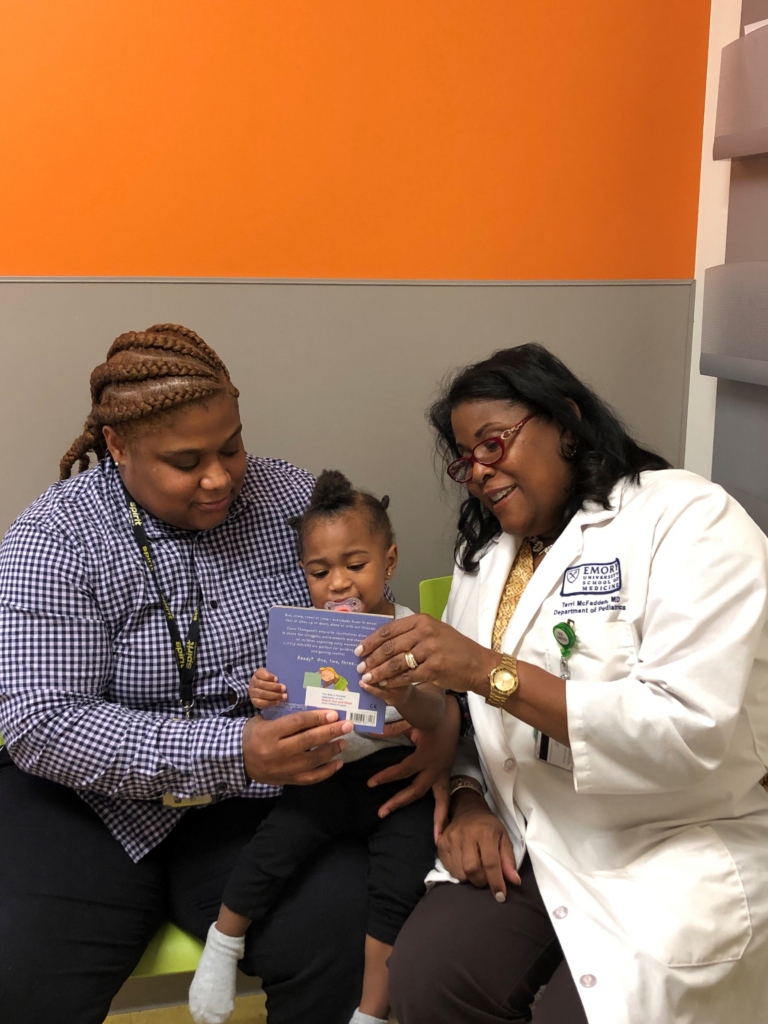
The Power of the Book
July 2024
By Dr. Terri McFadden
It was a typical afternoon in my Thursday resident continuity clinic. As I glanced up at our clinic patient tracking board, I realized that our residents would be quite busy! Indeed, they were busily making their way through the session, seeing patients as thoroughly and efficiently as possible.
As my resident discussed his next patient, an 18-month-old girl, I thought about my questions for him. Was her growth on track? Did she appear developmentally appropriate? And then obviously, “What was your interaction with her around the book that you gave?” This was an excellent resident, as they usually are. He looked at me and said, “I am so sorry, but I forgot the book.” This happens sometimes, so I directed him to go back into the room with the book and to engage the patient and mom using the book as a tool. “I’ll go with you and listen quietly.”
As we entered the room, the toddler was walking around screaming at the top of her lungs, while her young mother sat quietly looking at her phone. I thought to myself, “Oh boy. This may not go well.” But in an instant, the resident kneeled in front of the toddler and began to point out items in the colorful book that he had selected for her. She immediately stopped crying and began to point to the characters found on the page. Slowly, the mother looked up from her phone and began to watch the interaction between the resident and her daughter.
At this point, I decided to chime in, so I said to the mother, who was dressed in a work uniform and looked tired, “It seems as if Kayla really likes books!” The mother looked at me and said, “I guess so.” And our conversation began.
Eventually, we discussed the challenges that she faced as a young mother who worked as much as possible to provide for her family. In the end, she thanked us for the book and for the tips we provided for using it with her daughter. While a single book cannot address every one of the many issues that our families often face, in that moment, I was reminded of the power of the book in the hands of a caring clinician.

April 2024
By Dr. Perri Klass
There were at least four screens in the exam room with the toddler. There was the desktop computer, of course, with the EPIC chart open, and there was the monitor with the interpreter, and there was the phone in the hand of the toddler’s adolescent sister, who was busy texting, and there was the phone in the resident’s hand because he was looking up a medication that the mother had just handed over, something they had brought with them from another country, and trying to figure out what it was.
None of these were “bad” screens, or screens being used in “bad” ways. Everyone was using them appropriately, from the adolescent sibling who was quietly communicating with friends while obligingly spending the afternoon at a toddler’s primary care visit, to the resident, who was entering information into the electronic health record while double checking an unknown medication on the web. But in order to figure out why his patient might have taken that medication, he had to look to the monitor with the interpreter, ask the question that was translated for the mother who then took out her own cell phone and sent a text message, seeking more information from another family member.
In fact, that exam room was the locus of a miraculous amount of information transfer, interactions which would not have been possible without technology and screens. We had a trained medical interpreter present — virtually — so the mother could ask and answer questions in her own language (which was not one of the three or four more common languages in the clinic). We had the resources of the internet and also instant connections to extended family to help us figure out what had been going on with that medication. We had the electronic health record which, well, was what it is. That exam room was buzzing with language and meaning and words and even, if you will, with stories.
But the resident had also brought in a board book for the toddler, and I have to say, it was almost a physical relief to watch him hand it to his patient — a real book, a book you could hold and handle and chew on and manipulate and even throw on the floor and pick back up. The mother put her cell phone back in her pocket and smiled, and the resident reached over and helped the toddler open the book. The toddler pulled it away and handed it to his mother. Through the interpreter on the monitor, the resident said to her, “Look at the pictures with him! Tell him the names of the things in the pictures”. Through the interpreter on the monitor, the mother said she would. Through the interpreter on the monitor, the resident told the mother, he’s learning language all the time; he wants to hear your voice. Language and meaning and words and stories — they have to start somewhere.
